
Apple Macintosh before System 7

All information presented here is based on primary sources, mainly original, unmodified Apple disks and other Apple documentation.
Anyone interested in this history must be especially careful when reviewing the information presented in Apple Knowledge Base article TA31885 (last modified in 2001), Macintosh: System Software Version History, which is highly problematic:
- In the first table, "System 2.0 Finder 1.1g" should be System 1.1 Finder 1.1g.
- The first numbered "Macintosh System Software" release was version 5.0 in October 1987.
- The article assigns ex post facto version numbers to earlier releases and presents a timeline. Both are full of mistakes, which then carry over to Apple's tech specs and other documentation for early Macintosh hardware online. For details, see our discussion of how this mess was made: Apple's developer CDs and their spawn.
Understandably, this old Apple Knowledge Base article has been widely used as a source of (mis)information. Beware!
Sites with information about various aspects of early Macs include Low End Mac, Mac Daniel, 68k Mac FAQ, Mac 128 Update, Mac SE Support, Mac GUI, The Mothership, The Vintage Mac Museum, GUIdebook. Download sites include Macintosh Repository, Macintosh Garden, MacFixer. Discussions include Vintage Macs, System 6, and 68k Macintosh Liberation Army. Expert Classic Mac Tech Info is available in a PDF document here. Decode your 68k Mac serial number at myoldmac.net. First-hand history is available at Folklore and Making the Macintosh.
Mini vMac is an excellent Macintosh Plus, SE, and 128K emulator that runs on Mac OS X and earlier, as well as Linux and Windows. Requires the appropriate ROM. E-Maculation is a good place to check on the progress of other early Macintosh emulation projects.
Finally, Big Mess o' Wires offers the essential piece of equipment for anyone who owns a functional early Macintosh and wants to use it: a floppy/hard disk emulator that allows you to save your work to a current SD memory card.
Macintosh hardware releases
Table of hardware releases before System 7 (May 1991)
| Date |
Name |
Model # |
Tech Specs |
Original System file |
| 01/84 |
Macintosh (128K) |
M0001
M0001P* |
SP186 |
System 1.0† |
| 09/84 |
Macintosh 512K |
M0001W
M0001WP |
SP187 |
System 1.1‡ |
| 01/86 |
Macintosh Plus |
M0001A
M0001AP |
SP190 |
System 3.0 |
| 03/86 |
Macintosh 512K/800 |
M0001D |
n/a |
System 3.0 |
| 04/86 |
Macintosh 512Ke |
M0001E |
SP188 |
System 3.0 |
| 03/87 |
Macintosh SE |
M5010
M5011** |
SP191
SP192 |
System 4.0 |
| 03/87 |
Macintosh II |
M5000 |
SP193 |
System 4.1§ |
| 09/88 |
Macintosh IIx |
M5840 |
SP194 |
System 6.0.1 |
| 01/89 |
Macintosh SE/30 |
M5119 |
SP195 |
System 6.0.3 |
| 03/89 |
Macintosh IIcx |
M5650 |
SP196 |
System 6.0.3 |
| 09/89 |
Macintosh IIci |
M5780 |
SP197 |
System 6.0.4 |
| 09/89 |
Macintosh Portable |
M5120 |
SP140 |
System 6.0.4 |
| 03/90 |
Macintosh IIfx |
M5525 |
SP203 |
System 6.0.5 |
| 10/90 |
Macintosh Classic |
M0420 |
SP198 |
System 6.0.7 |
| 10/90 |
Macintosh IIsi |
M0360 |
SP199 |
System 6.0.7 |
| 10/90 |
Macintosh LC |
M0350 |
SP205 |
System 6.0.7 |
* "P" after the model number indicates a 220-240V power supply (Europe, Asia, Australia), as opposed to a 110-120V power supply (North America, Japan).
** M5011 was used for Macintosh SE machines configured with internal hard drives. This would later include the SE FDHD (SuperDrive), which replaced the SE in August 1989.
† Apple's recommended System file is version 2.0, with 3.2 as the maximum.
‡ Apple's recommended System file is version 3.2 (or 3.3 as an AppleShare client), with 4.1 as the maximum.
§ While both Macintosh SE and Macintosh II were introduced in March 1987, the II did not actually ship until April 1987, with System file version 4.1. See MacTech.
Printers: ImageWriter, LaserWriter, ImageWriter II, LaserWriter Plus, ImageWriter LQ, LaserWriter IISC, LaserWriter IINT, LaserWriter IINTX, Personal LaserWriter SC, Personal LaserWriter NT, Personal LaserWriter LS.
Monitors: High-Resolution Monochrome Monitor, High-Resolution RGB Monitor, Two-Page Monochrome Display, Macintosh Portrait Display, Macintosh 12-inch Monochrome Display, Macintosh 12-inch RGB Display.
Macintosh software releases
All of the information in the table below comes from original copies of the disks in question.
Table of software releases before System 7 (May 1991)
| Date |
Title |
System |
Finder |
MultiFinder |
| 01/84 |
Mac Software |
1.0 |
1.0 |
N/A |
| 05/84 |
Mac Software |
1.1 |
1.1g* |
N/A |
| 04/85 |
Mac Software |
2.0 |
4.1 |
N/A |
| 09/85 |
Mac Software |
2.1 |
5.0 |
N/A |
| 01/86 |
Mac Software |
3.0 |
5.1 |
N/A |
| 02/86 |
Mac Software |
3.1 |
5.2 |
N/A |
| 06/86 |
Mac Software |
3.2 |
5.3 |
N/A |
| 01/87 |
Macintosh System Software |
4.0 |
5.4† |
N/A |
| 04/87 |
Macintosh System Software |
4.1 |
5.5† |
N/A |
| 10/87 |
Macintosh System Software 5.0 |
4.2 |
6.0 |
1.0 |
| 11/87 |
Macintosh System Software 5.1 |
4.3 |
6.0 |
1.0 |
| 04/88 |
Macintosh System Software 6.0 |
6.0 |
6.1‡ |
6.0 |
| 08/88 |
Macintosh System Software 6.0.1 |
6.0.1 |
6.1 |
6.0.1 |
| 09/88 |
Macintosh System Software 6.0.2 |
6.0.2 |
6.1 |
6.0.1 |
| 12/88 |
Macintosh System Software 6.0.3 |
6.0.3 |
6.1 |
6.0.3 |
| 09/89 |
Macintosh System Software 6.0.4 |
6.0.4 |
6.1.4 |
6.0.4 |
| 03/90 |
Macintosh System Software 6.0.5 |
6.0.5 |
6.1.5 |
6.0.5 |
| 10/90 |
Macintosh System Software 6.0.7 |
6.0.7 |
6.1.7 |
6.0.7 |
| 04/91 |
Macintosh System Software 6.0.8 |
6.0.8 |
6.1.8 |
6.0.8 |
* System 1.1 supported at least two beta releases of the Finder (Finder 2.6 and Finder 3.4), widely distributed amongst developers, as discussed in MacTech: see the Letters sections of Volume 1, Issues 5 and 6.
† System 3.3 (for the Macintosh 512K) was distributed on the Work Station Installer disk for versions 1.0 (with Finder 5.4) and 1.1 (with Finder 5.5) of the AppleShare file server.
‡ System 3.4 (for the Macintosh 512Ke) was distributed with AppleShare version 2.0 (with Finder 6.1).
Notes:
- The two training disks that came with the original January 1984 software bundle (see below) used an early version of the Finder. The Macintosh icon is especially interesting, as it appears to show a prototype with a 5.25" disk drive like the first Lisa:
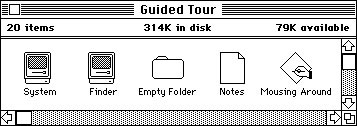
- The System file used on the January 1984 System Disk and Write/Paint disks is, technically, "Version .97 14-Jan-84." This resource was hidden from the public, for internal reference only. From the point of view of the public, this System file was numbered version 1.0. See the Disk Images page for more information.
- Finder 1.1h appears on the "Guided Tour of Macintosh" training disk, used in all software bundles from May 1984 up to January 1986 (see below).
- System 2.0 Finder 4.1 was released in April 1985. [disk images] MacWrite 4.5 and MacPaint 1.5 were released, along with an update disk that featured the application System Update (a.k.a. Finder Update, its icon appears at the bottom of this page) that could be used to update any startup disk. The Update disk also included the Font/DA Mover application, a Fonts suitcase with one font in it [Taliesin, a pictorial font], and a "What's New" document. A complete System Disk was not released until June 1985 (see below).
- System 2.1 Finder 5.0 was released on the first HD 20 Startup disk (with Hard Disk 20 1.0 and HD 20 Test 1.0) that shipped with the Hard Disk 20. Introduced support for the Hierarchical File System (HFS).
- System 3.0 Finder 5.1 was released on the first Macintosh Plus System Tools disk. This same disk also came with the first Macintosh Plus Disk Drive Kit.
- System 3.1 Finder 5.2 was only released on the Printer Installation (v1.0) [690-5075-A] disk that shipped with the LaserWriter Plus and featured LaserWriter 3.0 and LaserWriter Namer 2.0, along with an updated Font/DA Mover. Apple intended to ship System 3.1 (or, more likely, System 3.1.1) Finder 5.2 with the first Macintosh 512Ke machines, but for unknown reasons they used the earlier Macintosh Plus System Tools disk instead. System 3.1 Finder 5.2 was never released as a System disk, and System 3.1.1 Finder 5.2 is only found on the Macintosh 512K enhanced: A Guided Tour disk.
- System 3.2 Finder 5.3 was released in June 1986. [disk images] In addition to separate 800K System Tools disks for the Macintosh Plus and 512Ke, along with a 400K HD 20 Startup disk (with Hard Disk 20 1.1 and HD 20 Test 1.1), Apple distributed two 400K update disks:
- The System Installation (v1.0) disk came with two Installer scripts: "Mac Plus Update" and "External Drive."
- The Printer Installation (v1.1) [690-5075-B] disk featured LaserWriter 3.1 and LaserWriter Namer 2.1.
- The earliest references to "Macintosh System Software" are in the Read Me documents on the System 4.0 Finder 5.4 and System 4.1 Finder 5.5 disks.
- System 4.0 Finder 5.4 was released in January 1987. It came on two 800K disks:
- Macintosh System Tools (v1.0)
- Macintosh Utilities (v1.0)
- System 4.1 Finder 5.5 was released in April 1987. [disk images] It came on two 800K disks:
- Macintosh System Tools (v2.0). Revised June 1987 (v2.0.1).
- Macintosh Utilities (v2.0). Revised June 1987 (v2.0.1). Revised August 1987 (v2.1, two disks).
- Macintosh System Software 5.0 and 5.1 came on four 800K disks: System Tools 1, System Tools 2 (Printers), Utilities 1, Utilities 2.
- Macintosh System Software 6.0–6.0.5 came on four 800K disks: System Tools, Printing Tools, Utilities 1, Utilities 2. [disk images]
- Macintosh System Software 6.0.7–6.0.8 came on two 1.4 Mb (high-density) disks: System Startup and System Additions.
Four 800K disks were also available. [disk images]
Throughout 1987, Apple considered System file 3.2 (or 3.3 as an AppleShare client) to be the maximum for machines with 512K memory. By early 1988, however, this recommendation had been changed to System file 4.1:
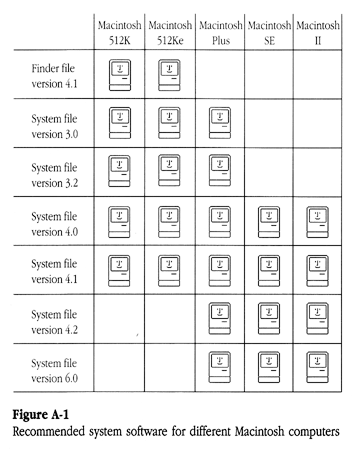
From "A History of Macintosh System Software," Appendix A in Macintosh System Software User's Guide Version 6.0 (1988).
Macintosh 128K and 512K hardware
The following information reflects the current state of my knowledge of Macintosh 128K [M0001 and M0001P] "Mac" and 512K [M0001W and M0001WP] "Fat Mac" hardware. It may not be complete, but it is accurate, based on personal experience and detailed reports from others, along with conclusions gleaned from the M0001 Registry.
There were three cases:
- Early M0001 cases that read "Macintosh" on the back.
- Later M0001 cases that read "Macintosh 128K" on the back. This change was made in week 47 of 1984 (November).
- M0001W cases that read "Macintosh 512K" on the back.
There were (at least) three generations of logic boards:
- [820-0086-C] © 1983, 128K (630-0101) only.
- [820-0086-F] © 1983-84, could be configured as either 128K (630-0101) or 512K (630-0118) boards.
- [820-0141-A] © 1983-84, could be configured as either 128K (630-0101) or 512K (630-0118) boards.
There were (at least) two generations of 128K/512K analog boards (630-0102):
- [820-0082-B] © 1983, had a metal shield that ran along the top at BB1. Apple later removed the shield to increase convective cooling.
- [820-0082-C] © 1983-84, had neither the shield nor BB1.
There were two generations of disk drives:
- Early Sony model OA-D34V.
- Later Sony models OA-D34V-02 or OA-D34V-22. These models had a new insert/eject mechanism.
There were two series of external disk drives (model M0130):
- Serial number started with D, made in USA.* The earliest of these contained Sony OA-D34V drives. Later they contained OA-D34V-02/22 drives.
- Serial number started with Y, made in Japan.* These contained Sony OA-D34V-02/22 drives.
* There is a difference between the two in the coloration of the plastic case. The plastic used for the D drives is the same as that used for early Macintosh machines. The plastic used for the Y drives is slightly different and does not yellow, at least not nearly as much.
Macintosh 128K and 512K manuals
Macintosh owner's guide:
- 030-0687 [Macintosh] owner's guide, 160 pp. © 1983. Covered System 1.0 Finder 1.0.
- 030-0687-A [Macintosh] owner's guide, 160 pp. © 1984. Content is the same as the first edition.
- 032-0001 [Macintosh System Update] insert. Dated January 25, 1984. [PDF] Included with both of the above editions.
- 032-0003 [Software Enhancements] insert, 3 pp. Added May 1984. [PDF] Introduced new features in System 1.1 Finder 1.1g.
- 030-0687-B [Macintosh] owner's guide, 165 pp. © 1984. Covered System 1.1 Finder 1.1g.
- 032-0017 [Macintosh Update: Finder and MacWrite] insert, 12 pp. Added June 1985. Introduced new features in System 2.0 Finder 4.1.
MacWrite manual:
- 030-0688 [MacWrite] manual, 143 pp. © 1983. Covered MacWrite 1.0.
- 032-0002 [MacWrite/MacPaint Update] insert. Dated January 25, 1984. [PDF]
- 030-0688-B [MacWrite] manual, 143 pp. © 1984. Covered MacWrite 2.2.
- 032-0012 [Macintosh Update: Disk-Based MacWrite] insert, 4 pp. Added April 1985. Introduced new features in MacWrite 4.5.
MacPaint manual:
- 030-0848 [MacPaint] manual, 32 pp. © 1983. Used for MacPaint versions 1.0 to 1.5.
Other items:
- [Macintosh] five-fold leaflet. "The Adventure Begins Here." A guide to setting up the machine and getting started, along with a packing list.
- [Limited Warranty on Hardware] card. Ninety (90) days!
- [Free MacWorld Offer] card. Two issues!
- Apple logo stickers. [January 1984]
- One blank disk with two blank labels.
Macintosh 128K and 512K software bundles

The first Macintosh 128K machines came with a plastic box that included:
- 690-5003A "System Disk" disk: System 1.0 Finder 1.0 [more info]
- 690-5002A "A Guided Tour of Macintosh" training disk
- 942-0387A [A Guided Tour of Macintosh] audio tape (Side 1: 027-0013A, Side 2: 027-0014A)
MacWrite and MacPaint came in a cardboard box that included:
- 690-5009A "MacWrite MacPaint" disk [2]: MacWrite 1.0, MacPaint 1.0 [more info]
- 690-5006A "MacWrite MacPaint: A Guided Tour" training disk
- 942-0417A [A Guided Tour of MacWrite MacPaint] audio tape (Side 1: 027-0015B, Side 2: 027-0016B)
Font Mover was included on the MacWrite MacPaint (Write/Paint) disk.
In May 1984, the software bundle was updated and reorganized for System 1.1 Finder 1.1g. Font Mover and the additional fonts were moved to the System Disk in order to create more space on the MacWrite MacPaint disk and a new MacPaint disk was added. The two audio tapes remained the same [with the recordings updated?], and MacWrite MacPaint still came in a separate box:
- 690-5003B "System Disk" disk: System 1.1 Finder 1.1g* [disk image]
- 690-5002B "A Guided Tour of Macintosh" training disk (Finder 1.1h)
- [A Guided Tour of Macintosh] audio tape
- 690-5009B "MacWrite MacPaint" disk [2]: MacWrite 2.2, MacPaint 1.3
- 690-5011B "MacPaint" disk
- 690-5006B "MacWrite MacPaint: A Guided Tour" training disk
- [A Guided Tour of MacWrite MacPaint] audio tape
In September 1984, with the introduction of the Macintosh 512K, the bundle was changed so that all the components would fit inside the plastic Macintosh box:
- 690-5003-C or 690-5003-D "System Disk" disk: System 1.1 Finder 1.1g*
- 690-5023-A "System and MacWrite MacPaint: Back-Up" disk: MacWrite 2.2, MacPaint 1.4 [disk image]
- 690-5024-A "MacWrite" disk [disk image]
- 690-5011-C "MacPaint" disk [disk image]
- 690-5002-C "A Guided Tour of Macintosh" training disk (Finder 1.1h)
- 690-5006-C "MacWrite MacPaint: A Guided Tour" training disk
- 685-0011-A [A Guided Tour of Macintosh and MacWrite MacPaint] audio tape (Side 1: 027-0021-A, Side 2: 027-0022-A)
* There is no difference in content between the 690-5003B, 690-5003-C, and 690-5003-D disks. The different part numbers reflect changes in the packaging.
In June 1985, the software bundle was updated for System 2.0 Finder 4.1. The training disks and audio tape remained the same:
- 690-5003-E "System Disk" disk: System 2.0 Finder 4.1 [disk image]
- 690-5023-B "System and MacWrite MacPaint: Back-Up" disk: MacWrite 4.5, MacPaint 1.5
- 690-5024-B "MacWrite: Disk Based" disk [disk image]
- 690-5011-D "MacPaint" disk [disk image]
- 690-5002-C "A Guided Tour of Macintosh" training disk (Finder 1.1h)
- 690-5006-C "MacWrite MacPaint: A Guided Tour" training disk
- 685-0011-A [A Guided Tour of Macintosh and MacWrite MacPaint] audio tape (Side 1: 027-0021-A, Side 2: 027-0022-A)
Macintosh Plus and 512Ke hardware
Macintosh Plus
All original Macintosh Plus [M0001A and M0001AP] machines had the words "Macintosh Plus" on the front and came with the M0110A extended keyboard. There were three generations:
- "Beige" Macintosh Plus machines read "Macintosh Plus 1 Mb" on the back, with no copyright date. Beige was also the color of the Macintosh 128K and 512K, as well as the 512Ke.
- In 1987, Apple changed the label on the back to read "Macintosh Plus 1 Mb" with a 1987 copyright date. The case color was changed to "platinum" to match the color of the new Macintosh II and SE machines. The owner's guide was redesigned and revised (see below).
- In 1988, Apple changed the label on the back to read "Macintosh Plus" with a 1988 copyright date. The owner's guide was redesigned and revised again (see below).
The Macintosh Plus ROMs were revised twice. The second revision coincided with the release of the platinum machines in 1987.
Macintosh 512Ke
There were two generations of Macintosh 512Ke [M0001E] machines:
- Beige machines produced in 1986 have a label on the back with no copyright date. They came with the M0110 standard keyboard and contained first-revision Macintosh Plus ROMs. The location and design of the Apple logo on the front was the same as the original Macintosh and the 512K.
- Platinum machines have a 1987 copyright date on the label. They came with the M0110A extended keyboard and contained second-revision Macintosh Plus ROMs. The location and design of the Apple logo on the front was the same as the Plus.
Note: I have never seen a M0001E with a 220-240V power supply.
Macintosh 512K/800
The Macintosh 512K/800 [M0001D or M0001E, depending on the power supply required locally] was a 512Ke with a M0110A extended keyboard. To my knowledge, the 512K/800 was never sold retail in the United States. Like the first-generation 512Ke, the location and design of the Apple logo on the front was the same as the original Macintosh and the 512K.
The M0001D probably existed as a second-generation, platinum 1987 machine, but I have never seen one without "Macintosh ED" (see below) printed on the front.
Note: I have never seen a M0001D with a 110-120V power supply.
Macintosh ED
The Macintosh ED was a 512K/800 sold to educational institutions, mostly, if not entirely [?], outside of the United States. There were four editions of these machines:
- Beige with M0001ED model number. [Serial numbers begin with F, for Fremont, California]
- Platinum with M0001ED model number.
- Beige with "Macintosh ED" printed on the front and M0001D model number on the back. [Serial numbers begin with C, for Cork, Ireland.]
- Platinum with "Macintosh ED" printed on the front and M0001D model number on the back.*
* A 1987 Dutch edition of the "Macintosh ED Addendum" booklet, covering System 4.0 Finder 5.4, has come to light. You can download a PDF at Macintosh Garden.
Macintosh Plus ED
The Macintosh Plus ED was a platinum Macintosh Plus with "Macintosh Plus ED" printed on the front.
Note: I have never seen a Macintosh Plus ED with a 110-120V power supply.
Macintosh Plus and 512Ke manuals
Macintosh Plus
Changes in the design of the Macintosh Plus owner's guide (along with the software bundle) parallel the changes in the hardware.
First edition:

- 030-1246-A [Macintosh Plus] owner's guide, 183 pp. © 1986. Covered System 3.0 Finder 5.1.
- 032-0027 [Important Macintosh Plus Information] insert, 4 pp. January 1986.
- 030-1246-B [Macintosh Plus] owner's guide, 183 pp. © 1986. Revised to include content from the January 1986 insert.
Second edition:
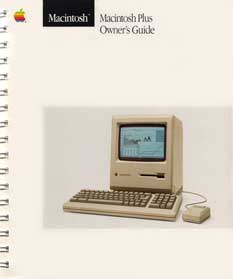
- 030-1242-A [Macintosh Plus Owner's Guide] 234 pp. © 1987. Covered System 4.0 Finder 5.4. Bundled with:
- 030-3173-A [Macintosh Utilities User's Guide] 54 pp. © 1987.
- Replaced by the manuals for Macintosh System Software 5.0 in October 1987:
- 031-1302-A [Macintosh New Features Update] insert, 21 pp. © 1987.
- 030-5623-A [MultiFinder User's Guide] 35 pp. © 1987.
- 030-2133-A [Macintosh Utilities User's Guide] 109 pp. © 1987.
Third edition:
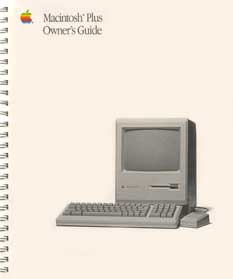
- 030-3294-A [Macintosh Plus Owner's Guide] 101 pp. © 1988.
- Bundled with the manuals for Macintosh System Software 6.0:
- 030-3281-A [Macintosh System Software User's Guide Version 6.0] 274 pp. © 1988.
- 030-3283-A [Macintosh Utilities User's Guide] 171 pp. © 1988.
- 030-3294-B [Macintosh Plus Owner's Guide] 101 pp. © 1988. Updated the Unpacking guide, along with the Technical Information and Guide to Technical Documentation chapters.
- Bundled with the manuals for Macintosh System Software 6.0.4:
- 030-3399-A [Macintosh System Software User's Guide Version 6.0.4] 275 pp. © 1989.
- 030-3418-A [Macintosh Utilities User's Guide] 166 pp. © 1988.
Macintosh 512Ke
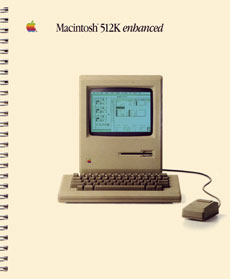
- 030-1326-A [Macintosh 512K enhanced] owner's guide, 181 pp. © 1986. Covered System 3.0 Finder 5.1.
Sales of the Macintosh 512Ke continued until September 1987. Apple did not update the 512Ke owner's guide along with that of the Macintosh Plus. At the time, Apple considered System 3.2 Finder 5.3 to be the maximum for machines with 512K of memory. [It was only later that System 4.1 Finder 5.4 was declared the maximum.] This fact may explain why no effort was made to update the 512Ke owner's guide and software bundle for the second-generation 512Ke in 1987 (see above), while the Plus received a complete overhaul.
Macintosh Plus and 512Ke software bundles
Before April 1988, all Macintosh Plus and 512Ke software bundles included a demo disk for MacDraw, MacWrite, MacProject, MacPaint.
Macintosh Plus
In January 1986, the Macintosh Plus software bundle featured System 3.0 Finder 5.1:
- 690-5064-A "Macintosh Plus: System Tools" disk (v1.0) [2]
- 690-5065-A "Macintosh Plus: A Guided Tour" training disk (v1.0)
- [Macintosh Plus: A Guided Tour] audio tape
In June 1986, the System Tools disk was updated for System 3.2 Finder 5.3:
- 690-5064-B "Macintosh Plus: System Tools" disk (v1.1) [2] [disk image]
In January 1987, the software bundle was updated for System 4.0 Finder 5.4:
- "Macintosh: System Tools" disk (v1.0)
- "Macintosh: Utilities" disk (v1.0)
- "Your Apple Tour of the Macintosh Plus" training disk (v1.1)
In April 1987, the software bundle was updated for System 4.1 Finder 5.5:
- "Macintosh: System Tools" disk (v2.0)
- "Macintosh: Utilities" disk (v2.0)
- "Your Apple Tour of the Macintosh Plus" training disk (v1.1)
In June 1987, the System Tools and Utilities disks were revised:
- 690-6023-B "Macintosh: System Tools" disk (v2.0.1) [disk image]
- 690-6024-B "Macintosh: Utilities" disk (v2.0.1)
- 690-5157-B "Your Apple Tour of the Macintosh Plus" training disk (v1.1)
In August 1987, the Utilities disk was revised a second time, on two disks:
In October 1987, the software bundle was updated for Macintosh System Software 5.0, on four disks: System Tools 1, System Tools 2 (Printers), Utilities 1, Utilities 2.
In April 1988, the software bundle was updated for Macintosh System Software 6.0, on four disks: System Tools, Printing Tools, Utilities 1, Utilities 2. HyperCard was also added to the box:
- 690-5209-A "Your Apple Tour of the Macintosh Plus" training disk (v2.0)
- "HyperCard and Stacks"
- "HyperCard Help"
- "HyperCard Ideas"
Macintosh 512Ke
The Macintosh 512Ke shipped in April 1986. It came with the earlier Macintosh Plus System Tools disk:
- 690-5064-A "Macintosh Plus: System Tools" disk (v1.0, System 3.0 Finder 5.1) [2]
- 690-5090-A "Macintosh 512K enhanced: A Guided Tour" training disk (System 3.1.1 Finder 5.2)
- [Macintosh 512K enhanced: A Guided Tour] audio tape
In June 1986, the System Tools disk was updated for System 3.2 Finder 5.3 and the Macintosh 512Ke:
- 690-5091-A "Macintosh 512K enhanced: System Tools" disk (v1.0) [2] [disk image]
Sales of the Macintosh 512Ke continued until September 1987, but the software bundle did not change after June 1986. For more on this, see above.
Apple OEM upgrades
Apple's OEM (Original Equipment Manufacturer) upgrades:
- [Macintosh 512K Memory Expansion Kit]
- Result was equivalent to a Macintosh 512K.
- Replaced 128K logic board with 512K logic board.
- [Macintosh Plus Disk Drive Kit]
- Result was equivalent to a Macintosh 512Ke. Could also be performed on a Macintosh 128K, resulting in a Macintosh 128Ke.
- Replaced 400K internal disk drive with 800K internal disk drive.
- Replaced 64K ROM chips with 128K ROM chips on the logic board.
- Included current Macintosh Plus System Tools disk.
- Included 030-1245-A or 030-1245-B [Macintosh Plus Internal Disk Drive] upgrade guide, 43 pp. © 1986. A thorough introduction to Finder 5.x and the Hierarchical File System (HFS).*
- [Macintosh Plus 1 Mb Logic Board Kit]
- Result was equivalent to a Macintosh Plus.
- Macintosh 128K/512K required Macintosh Plus Disk Drive Kit (above).
- Replaced 128K/512K/512Ke logic board with Plus logic board.
- Replaced 128K/512K/512Ke back panel with Plus back panel. Machines upgraded with this kit thus read "Macintosh Plus 1 Mb" on the back, but don't say "Macintosh Plus" on the front.
- Included current Macintosh Plus owner's guide.
- Macintosh Plus memory upgrades. Result was a Macintosh Plus with up to 4 Mb of memory.
- Replaced 256K plug-in memory modules with 1 Mb modules. You could replace either two or four modules, resulting in 2560K (2.5 Mb) or 4096K (4 Mb) of memory.
* As far as I know, this is the only printed Apple manual that tells you how to initialize single-sided 400K disks in the HFS format. Requires Finder 5.x or 6.x: "Holding down the Option key while you click One-Sided (or if the disk is in a 400K disk drive, holding the Option key down while you press the Return key after you've named it) installs the hierarchical file system on just one side of the disk. Use disks initialized this way with updated startup disks only." In other words, they can't be used as startup disks. Or else!


